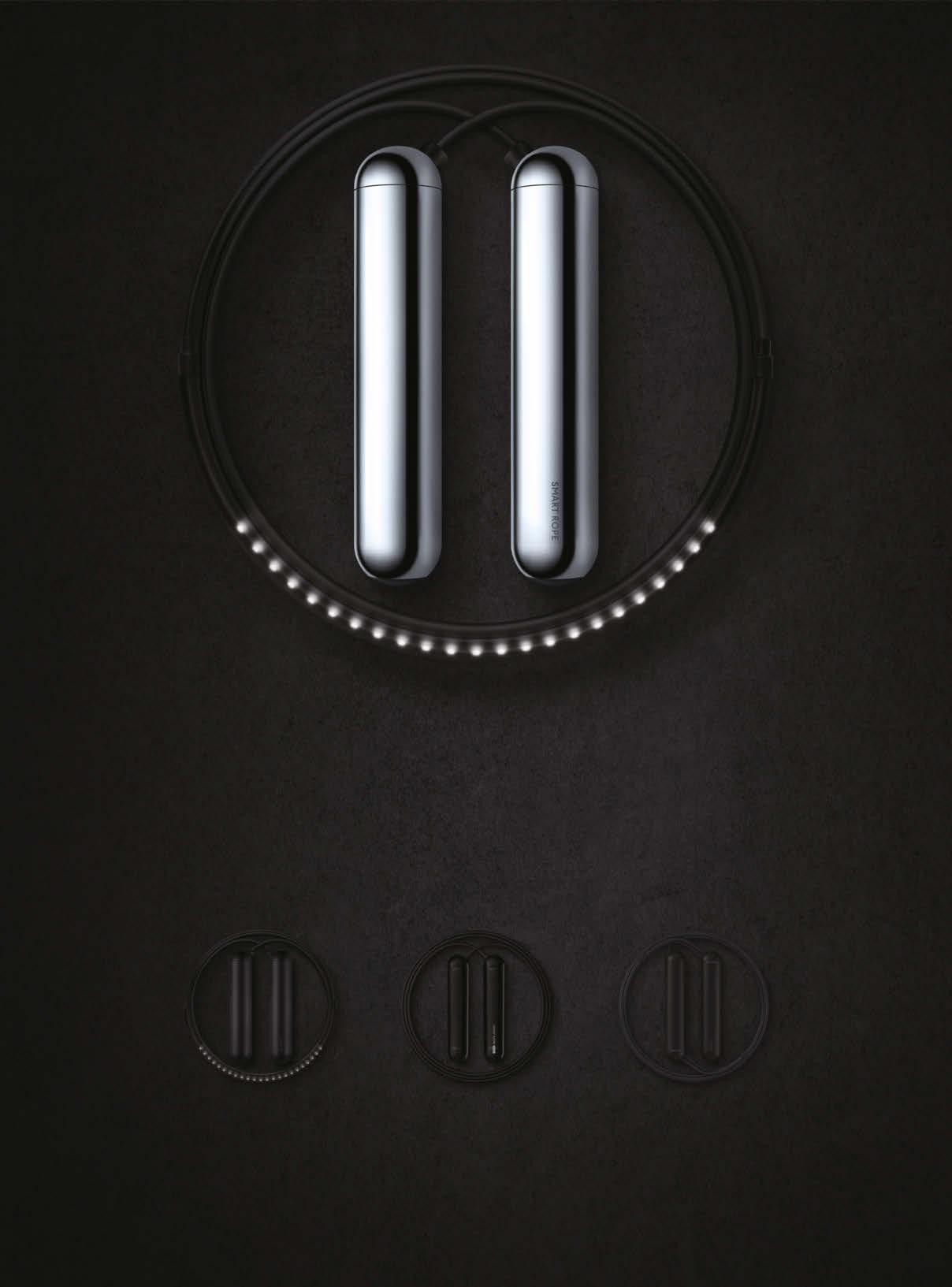
36 minute read
Time to Rally
Bryce Menzies tackles the 2020 Mint 400 in his trophy truck, a vehicle capable of jumping more than 150 feet. “You’re doing four laps of 100 miles,” says the two-time overall winner (2013 and 2018). “It’s an iconic race.”

A 428-mile blast through the Mojave Desert, the Mint 400 began in 1968 as a PR stunt to promote the annual deer hunt of Las Vegas hotel and casino the Mint. But the event, which starts and finishes just beyond the glare of the Las Vegas Strip, soon transformed into something bigger: the “Great American Off-Road Race.” “I first went in 2018,” says British photographer Gavin Bond. “It was the 50th anniversary, and I knew nothing about it. My producer in L.A.—this English guy called Skinny—is an amateur petrolhead. He got one of those competition trucks and entered, so I went along. I fell in love with the race and knew I had to go back to shoot it.” And that’s what he did in March 2020. What Bond didn’t know at the time was that the motorsports scenes he’d capture would be among the last before everyday life transformed forever—two weeks later, the world went into lockdown.
A year on, the world has changed in many ways, but against the odds, the Mint 400 is back. This isn’t the first time the event has been in peril—for two decades it didn’t run at all. When casino owner Jack Binion bought the Mint hotel and casino in 1988, he shut down the race, as he believed it negatively impacted on his businesses. It wasn’t until 2008 that the rights were bought by Matt and Joshua Martelli, filmmakers of the successful viral motorsports series Ken Block’s Gymkhana. Today the Mint and many surrounding casinos are long gone, replaced by entertainment complexes. But the race endures, just as it did throughout the era of the Hollywood macho man—the likes of Steve McQueen and James Garner took part—and also the birth of gonzo journalism; it was while covering the Mint 400 for Sports Illustrated that author Hunter S. Thompson was inspired to pen his ode to the lost American Dream, Fear and Loathing in Las Vegas. “You couldn’t have anything more ‘America,’” says Bond of the race. The photographer set out to document a sporting event, but, like Thompson, he found something more raw and fascinating. The Mint 400 is scheduled to take place March 3-7 in Las Vegas; themint400.com
The day before the main race, bikes take to the field. “They were part of the original Mint 400, mixed in with the cars, which was crazy,” says co-owner Matt Martelli. “That stopped [in 1976] for insurance reasons. We brought them back in 2018.” Two vintage classes (1980-90, and earlier) are mixed in with pro and amateur riders, a women’s category and even father/son teams. “Bikes have always been the gateway to offroading. Most racers started on one.”
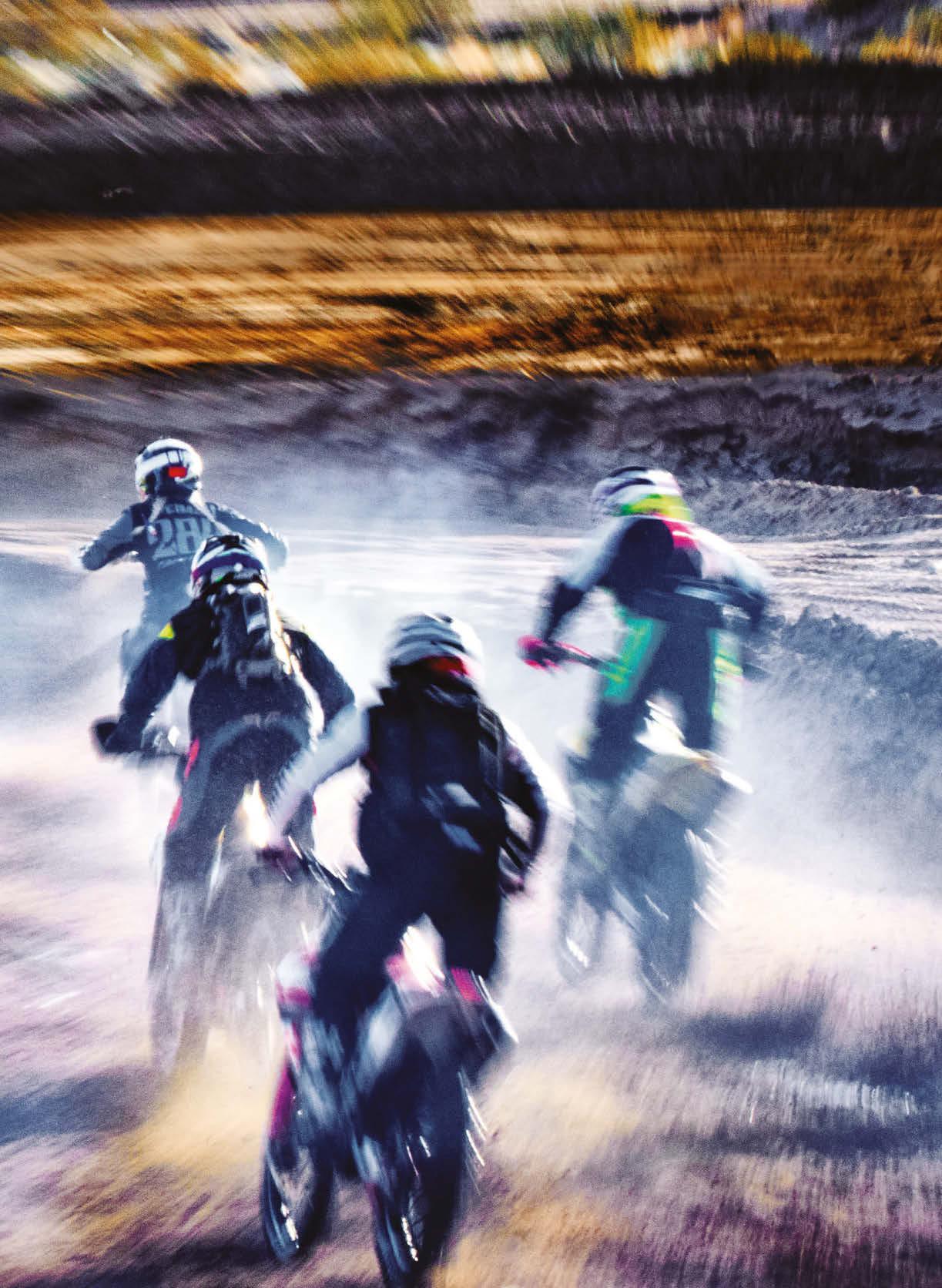
Photographer Gavin Bond

Left: Red Bull driver Seth Quintero waits by his UTV Pro N/A (utility terrain vehicle, non-aspirated; meaning it isn’t turbo- or supercharged). In 2019, at age 16, the Alabamaborn rider entered the history books as the youngest Mint 400 winner in the UTV Pro Turbo category. “This shot is before the race. It’s hot and they just want to get out on the track,” says Bond. Quintero failed to finish in 2020 after crashing out.
Opposite page: A mix of trophy trucks and UTVs in action.








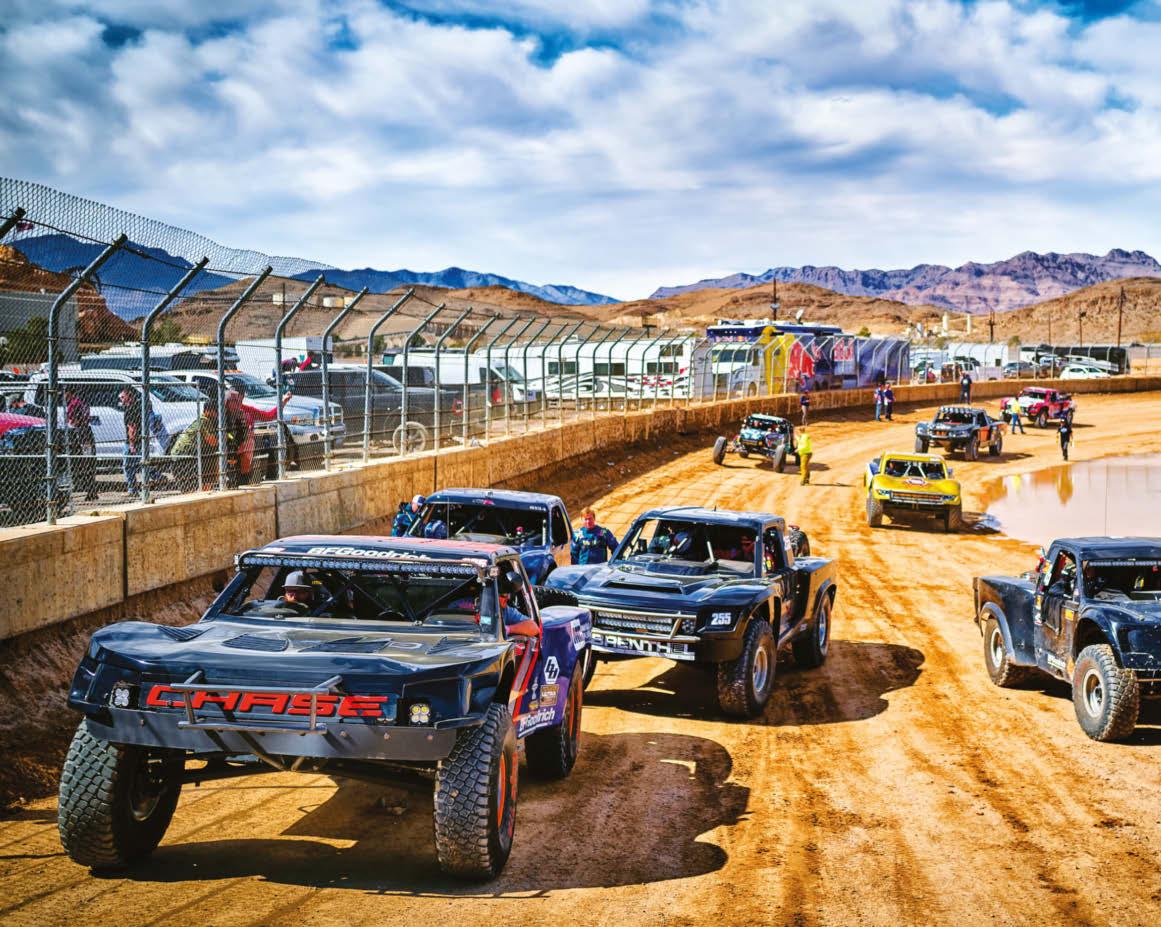
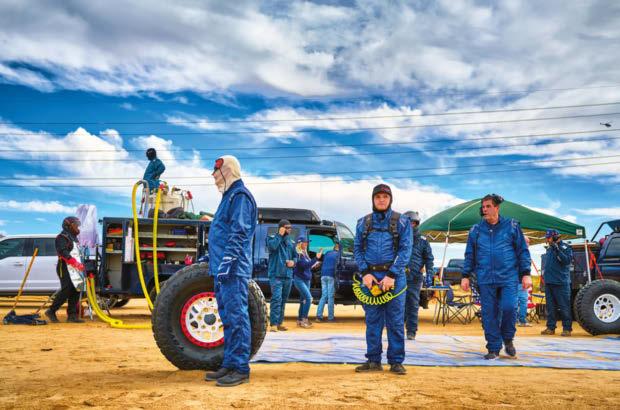
Above: “The calm before the storm—a 400-mile war in the Mojave Desert for the next six to 12 hours,” says Martelli of the race start. “As these guys drive around, helicopters are flying around, getting intel on the race and explaining to the drivers who they’re chasing,” says Bond. “That’s how much money they throw at this thing.”
Left: “There are three pits: two in the desert; this one is by the start,” says Bond. “I had radio info that Bryce Menzies [pictured this spread, far right] was about to refuel, so I raced back and got this great shot of Red Bull waiting there with the fuel lines ready . . . but the car just didn’t stop.”



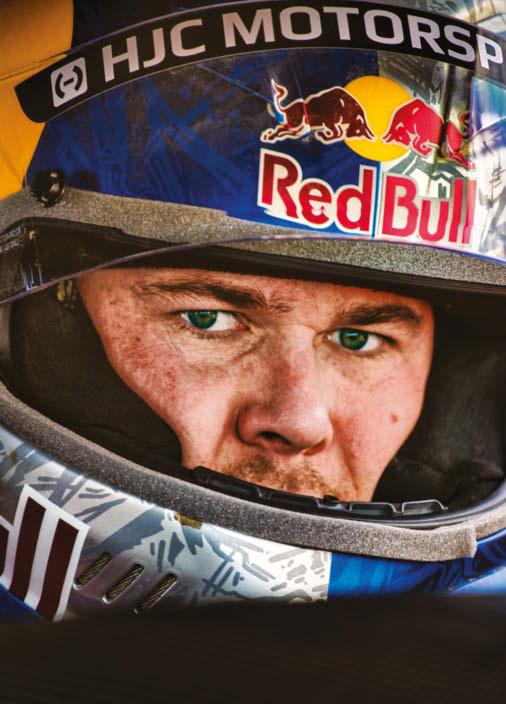
Joseph Jepsen of the Diamond J Racing team in his Alumi Craft open-wheel buggy. “This is in Class 10—the ‘racer’s class,’ with equal cars—which is very competitive,” says Martelli. “I’m shooting with a long lens,” says Bond. “But I’m probably closer than I should be. You’re out in the middle of nowhere with five or six other photographers, all trying to get the best shot, and sometimes you get led astray.”

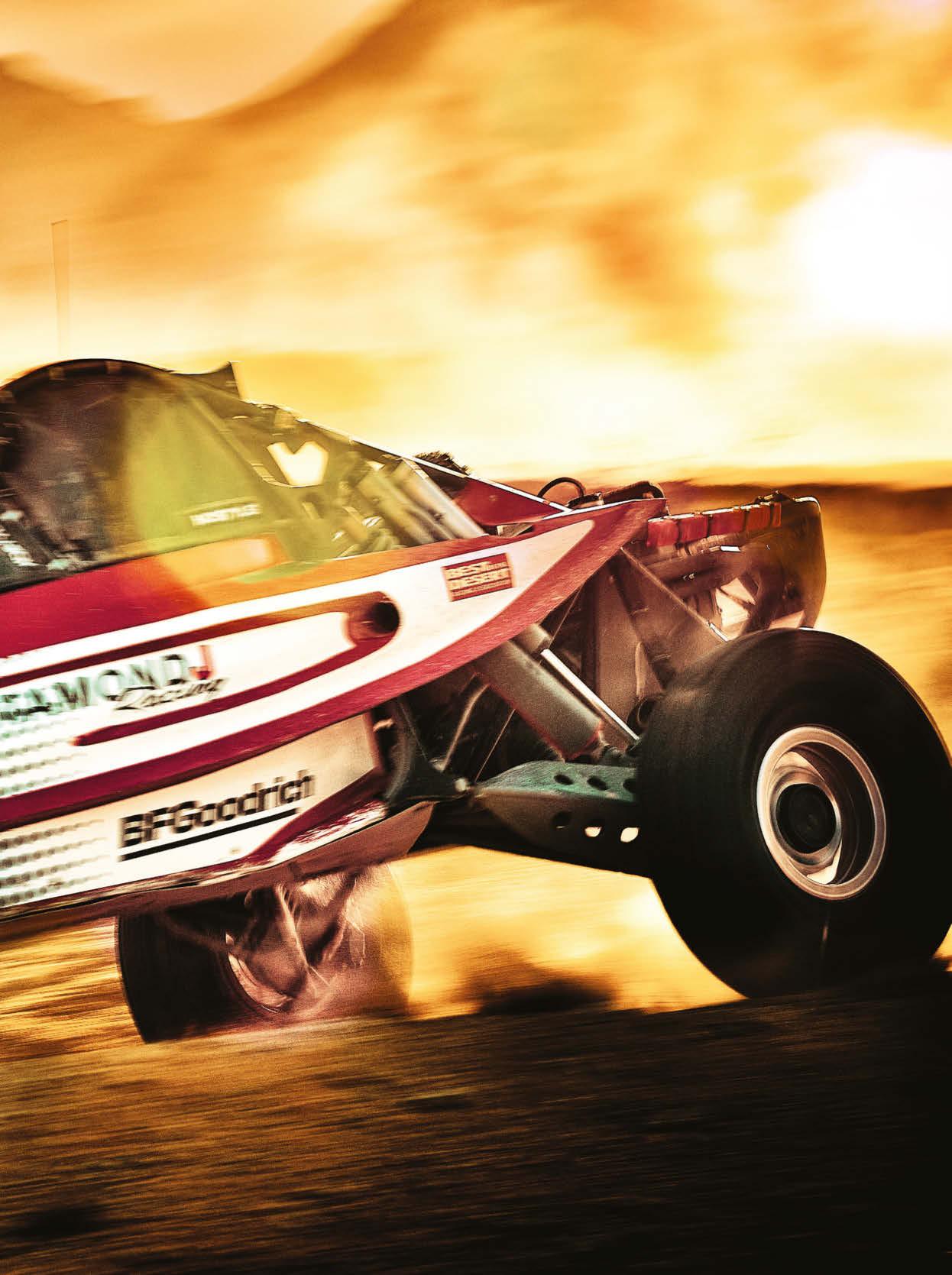
guideGet it. Do it. See it.

BEYOND THE ROPES
If you want to carve thigh-deep snowy turns without social-distancing concerns, try backcountry skiing at these three powder paradises.
Words HEATHER BALOGH ROCHFORT Earn that descent with a lift-free climb at Bluebird.
Human-Powered BLUEBIRD BACKCOUNTRY, COLORADO
After a successful two-week soft launch last spring, Colorado’s first backcountryonly ski resort opened on New Year’s Eve, proving that “inbounds backcountry” isn’t an oxymoron. Located 2.5 hours northwest of Denver on 1,200 acres of private land in north-central Colorado, Bluebird aims to reduce the barriers to entry in the sport. “We believe backcountry skiing is difficult and dangerous to learn, but it doesn’t need to be that way,” says co-founder Erik Lambert. “So we combined the amenities of a ski resort with the benefits of the backcountry and the benefits of a guide service to solve the problem.” The result: avalanche-evaluated backcountry terrain suitable for beginners and advanced skiers alike. While Bluebird doesn’t do any type of avalanche blasting or snow grooming, its ski patrol and dedicated team of volunteers does monitor the conditions to encourage guest safety. This includes mechanical practices like compaction and ski cutting that harden the snow to prevent depth hoar, a persistent weak layer of snowpack frequently responsible for avalanches. “We’re pretty conservative about what’s open and what’s not,” Lambert says. “We can give people the same reasonable expectation of safety that any ski area would.”
Still, Bluebird isn’t like other ski areas. After securing a (noticeably cheaper) day pass, skiers laden with the Big Three (avalanche beacon, avalanche shovel and probe) are checked by ski patrol before beginning the uphill journey. No chairlifts exist at Bluebird, so everyone must climb the mountain in order to ski down. Perched on the side of 9,845-foot Bear Mountain, Bluebird offers a variety of ungroomed terrain ranging from beginnerfriendly mellow meadows to steep drops and tight aspen glades for more experienced folks. (Diehard skiers can hire a private guide to venture into an additional 3,000 acres of gnarly, unmitigated terrain.) The ski area even has a trail map with the oft-referenced symbols like blue square and black diamond commonly
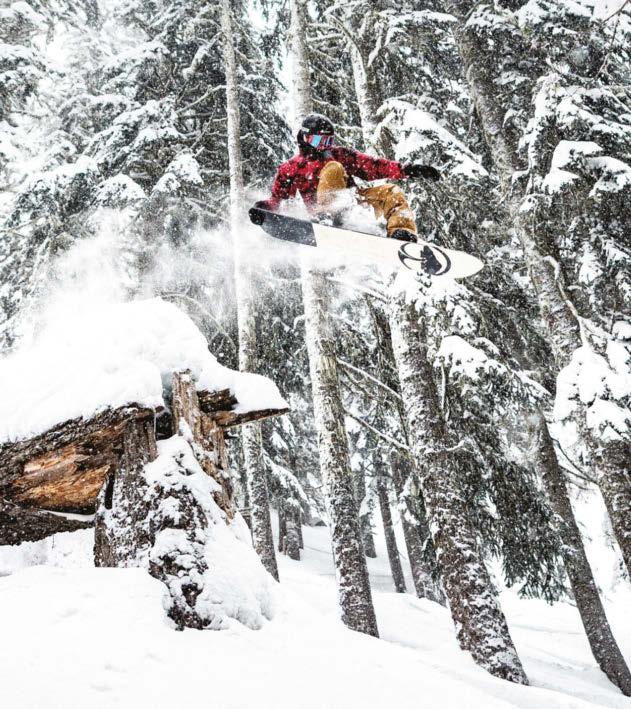
Inbounds backcountry at Bluebird. Powdery bliss at Stevens Pass.

used at standard ski resorts. This ensures backcountry newcomers feel welcome with skiing suited to their abilities. “Ultimately, we have four goals: improve access, reduce barriers, reimagine backcountry education and create a social hub for the backcountry community,” Lambert explains.
There’s an added bonus, too: Bluebird is highly sustainable. Not only is the mountain entirely humanpowered (no snow machines either), but the few scattered buildings are all semipermanent and removed at the end of the season. The two larger structures at the base and the few geodesic-dome warming huts scattered on the mountain are all deconstructed in April and rebuilt every November to comply with the landowner’s lease requirements. Since the region is used for cattle grazing in the summer, the buildings must disappear until the next ski season. Make it happen: Due to the lack of man-made snow, Bluebird has a shorted season and closes at the end of March. Until then, it’s open Thursdays-Mondays and does not require any advance reservations. Season passes, 4-packs and 10-pack day passes are all available on the website.
Lift-Served STEVENS PASS, WASHINGTON
If you prefer face shots and sleeper pow with a side of chairlifts, Stevens Pass Ski Area is the backcountry mecca for you. Situated 90 minutes east of Seattle with a base elevation of 4,000 feet, Stevens Pass is a traditional, chairlift-driven resort known


for delightfully inaccurate weather reports that dump more snowflakes than predicted. But while everyday skiers come for the standard inbounds terrain, powder hounds know that the best stuff exists beyond the lift. The epochally scary-andexposed Seventh Heaven chairlift sweeps skiers uphill to the area’s top ridgeline, known as Cowboy Ridge. From there, all that stands between the intrepid and their bliss is a quick bootpack to the gates separating the ski area from the backcountry. Suited for advanced skiers only, stashes of steep-anddeep technical turns await through a series of often spicy and occasionally deathdefying chutes that empty skiers back to the inbounds terrain. “You get everything at Stevens: awesome glades, steep lines and beautiful views,” says Seth Yates, a marketing pro based in Seattle. “And the chairlift does the work for you.” Make it happen: Pay attention to the state’s rules regarding outside visitors, as they are fluid this year. Stevens Pass Ski Area is requiring reservations with season pass holders taking priority, so be sure to plan ahead—and don’t forget your avy gear if you’re leaving the groomers.
Silverton has thousands of acres accessible only by hiking or helicopter.
Heli-Served SILVERTON, COLORADO
At first glance, Silverton Mountain may look like a traditional ski resort with a single chairlift winding its way up the slope. But Silverton isn’t for the faint of heart. While the scruffy two-seat chairlift (retired from California’s Mammoth Mountain) provides access to 1,819 acres of avalanchecontrolled backcountry terrain, the heart of Silverton beats in the additional 22,000 acres that are only accessible by hiking or helicopter. These wild-andsteep slopes are often referred to as “vertigo-inducing” due to their sheer and impossibly steep nature. Combined with 400 inches of annual snowfall and a summit elevation of 13,487 feet, Silverton isn’t for beginners or even intermediate skiers. In fact, the terrain is so advanced that the mountain only allows guided group skiing (maximum of eight people) for most of the winter. “Deep and steep doesn’t begin to describe that place,” says Javier Pineda, a paralegal from Frisco, Colorado. “Silverton offers solitude, stoke and a hunger for more.” Skiers wanting to level up on the adrenaline can also catch the heli. Silverton is the only ski resort in the continental United States to offer single-drop helicopter runs. It’s like an à la carte menu filled with powder refills. Make it happen: Both helicopter (seven days per week) and guided seasons (Thursdays-Sundays) are up and running until March 14, 2021. For folks wanting to visit unguided, that’s available five days per week, March 17-April 18.
KNOW BEFORE YOU GO
Arm yourself with the proper gear and safety equipment to ensure your return to the parking lot.
SAFETY GEAR
Avalanche Beacon Don’t leave home without one. We like the Black Diamond Guide BT beacon for its multiple-burial search capabilities. Shovel Plastic is lighter but aluminum is stronger during backcountry rescues. A good option is the Ortovox Pro Alu. Probe Used to pinpoint the location of a buried individual. Choose a probe that’s longer than 2 meters; we recommend the Black Diamond Quickdraw Tour Probe 280. Backpack Avalanche backpacks are pricey but may be worth it if you’re caught in a slide. Our rec: Osprey’s new Soelden/ Sopris Pro pack.
SKI GEAR
Skis Consider the terrain you’ll ski before making your selection. We’re loving the WNDR Alpine Intention 110s and their commitment to the environment. The brand ditched petroleum-based plastics in favor of algaebased bioplastic. Bindings Alpine-touring (AT) bindings are different from regular ski bindings, so you’ll need a new set if skiing uphill. We like the Salomon S/Lab Shift MNC 13 bindings. Ski Boots You’ll also need a pair of AT boots that are comfortable on the uphills while still crushing the descent. We suggest the Tecnica Zero G Tour Pro.
TRAIN LIKE A PRO “IT’S ALL ON ME”
Nick Lorenz reveals how he prepares for the high-impact sport of snocross.
Nick Lorenz is a star in the high-speed sport of snocross racing. At speeds of up to 60 mph, he maneuvers his snowmobile around a tight, technical course, expertly threading through a pack and sending it high over a series of jumps. “Racing is high intensity and high heart rate,” he says. Growing up in Kenosha, Wisconsin, Lorenz spent his winters riding snowmobiles out on the trails (and riding motocross bikes in the summer). At age 7 he began racing snowmobiles. “I fell in love with the sport,” he says. He turned professional when he was 18. After two years of injuries interrupted his progress, Lorenz, now 22, competed in his second full year in the Pro Lite class in 2020. Last February he scored his first pro victory at the Seneca Allegany AMSOIL national championship series event. “When I’m out there on the track, it’s my fitness and my racecraft,” says Lorenz. “It’s all on me.”

“Once the light turns green, it’s whoever can hit the throttle the fastest and get to the corner first,” says Lorenz.
RACECRAFT “The race start is half the battle”
“If you get off first, you’re not stuck behind people where you can’t see. With the hole position, I can set the pace for the whole field. I do a lot of testing for starts, and having really good clutching is key. I had a hole-shot device made so that I can practice. It’s a handlebar- and-throttle setup, and I can practice going off a red light. I’ll repeat that a few times the week prior to a race and even on race day. It helps me get used to the muscle reflex of hitting the throttle and watching the light disappear.”
STRENGTH “I strength train twice a week”
“We stop racing in March, and I typically start training again in May. I have a couple strength days each week. I do a 4,000-meter row or a 2-mile run to start off and get warmed up. I work with kettlebells and do squats and do a lot of body-weight stuff like push-ups. I do a new set every minute for a total of 10 minutes. I also do a lot of knee stability workouts, like single-legged Roman deadlifts, so that I can build balance and strength in that area.”
CARDIO “A long cardio workout is a good mental test”
“When there’s no snow, I do a lot of work on a rowing machine. I also ride my road or mountain bike for up to two hours. I use the road bike for interval workouts. My motocross bike is a total body workout that’s similar to snocross. The dirt bike’s a little easier on the body, so I use it for cross training. It’s good for timing, endurance and in-themoment decision making. I have a Polar heart rate monitor. I use it to track my sleep schedule and my resting heart rate. Then I know how I need to train the next day.”
RECOVERY “Yoga helps keep me loose”
“After I do a hard workout, I like to stretch and roll out my muscles. Snowmobile racing is super rough on your body. If I’m riding—on test days and riding days—I’ll do yoga afterward. If I ride four times a week, I’ll do yoga every night. It gives me flexibility and mobility. It keeps me loose and I just get to know my body more. I’ve had a couple of knee surgeries and other surgeries, so if I don’t stretch and do yoga, I notice it. I wake up the next day and I am a lot tighter.”
“I EAT SNACKS THROUGHOUT THE DAY”
“For breakfast I’ll have eggs, turkey bacon, yogurt and oatmeal. And then lots of carbs. A favorite is Jack Link’s protein snacks, and I like granola bars. After working out, I have a protein shake. I like chocolate protein and I hate mixing it with water. My go-to for my shake is unsweetened vanilla almond milk.”


Available now SKATE AFRICA
Kenyan capital Nairobi has more than 60,000 homeless kids. But some, like Ezra Nyongesa— known as Balo—and his friend Samuel Mwangi, are using skateboarding to get themselves off the streets. “We gave Balo a skateboard, and within months he knew how to kickflip,” explains George Zuko, who heads up the Skateboarding Society of Kenya, which built the Shangilia skatepark and an orphanage to help educate the children, give them a better life, and unlock their talents on a board. It’s just one of the true-life stories in this two-part series about skateboard culture in Africa. redbull.com
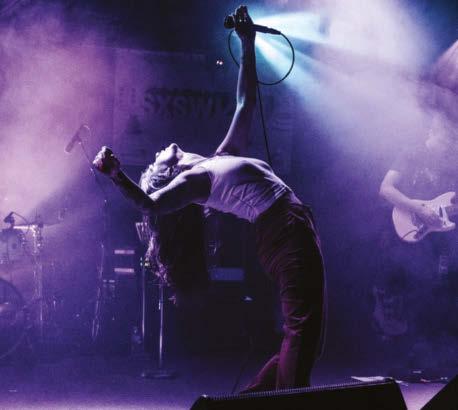
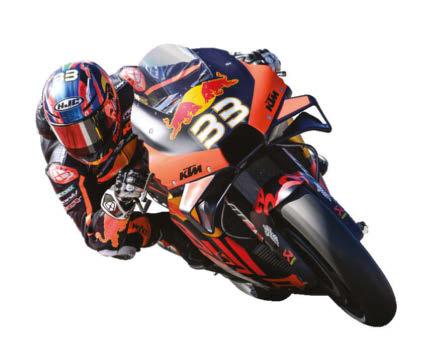
16
March SXSW ONLINE
Last year, the organizers of Austin’s beloved film, music and interactive media fest made the difficult but necessary decision to cancel the event as the country went into its first COVID lockdown. Now, with cases skyrocketing, SXSW is doing what many festivals have been doing for the past year: making it virtual. As of press time the lineup has not been released, but there will be film screenings and music showcases. Thru March 20; sxsw.com
16
March MARCH MADNESS
Despite some foreseeable (and unforeseeable) hurdles, the NCAA has committed to a tournament in 2021, but it will look very different and all games will happen in one central location—Indianapolis. Thru April 5; ncaa.com
Available now BRAD BINDER: BECOMING 33
The 25-year-old South African MotoGP rider, in 2020, became his country’s and team Red Bull KTM’s first- ever rookie winner. “Racing is the only thing I’ve ever wanted to do,” he says in this doc that tracks a career that began as a karting champ—at age 8. redbull.com
Available now HIP HOP RAISED ME
In 2016, Britain’s John Fairbanks, better known as hip-hop broadcaster and author DJ Semtex, released Hip Hop Raised Me—his definitive book on the history of rap music and its influence on four decades of culture, as well as on his own life (Semtex’s career began as a party promoter for popular nightclubs in the U.K.), featuring iconic photographs, memorabilia and interviews with artists like Kool Herc, Wu-Tang Clan, Eminem, Kanye West, Jay-Z, Nicki Minaj, Kendrick Lamar and more. Now, the 46-year-old presenter of Capital Xtra’s Fridaynight hip-hop show has launched a weekly podcast of the same name. “These are indepth conversations, no agenda,” says Semtex. “New cuttingedge artists, A-list artists, architects of sound. Moguls. Icons.” It debuted in January with Public Enemy’s Chuck D (who wrote the book’s foreword) discussing his own experiences in the hip-hop community. On all major podcast platforms; djsemtex.com
Available now LIFE OF KAI
Born in Maui, Hawaii, to a Californian windsurfer (his mom) and surfer (his dad), Kai Lenny has grown up among the waves and at 28 is a surfing superstar. What is it like to live such a life? Find out in this series, as a camera crew shadows Lenny for four months during the 2019-2020 surf season, as he intends to fulfill an ambition to become the world’s best bigwave surfer. It introduces us to his wave-loving parents, his coach and his high-performance training regime to take on Code Red swells in Hawaii, heats in the World Surf League and the greatest challenge of all—the gigantic waves at Nazaré, Portugal. redbull.com

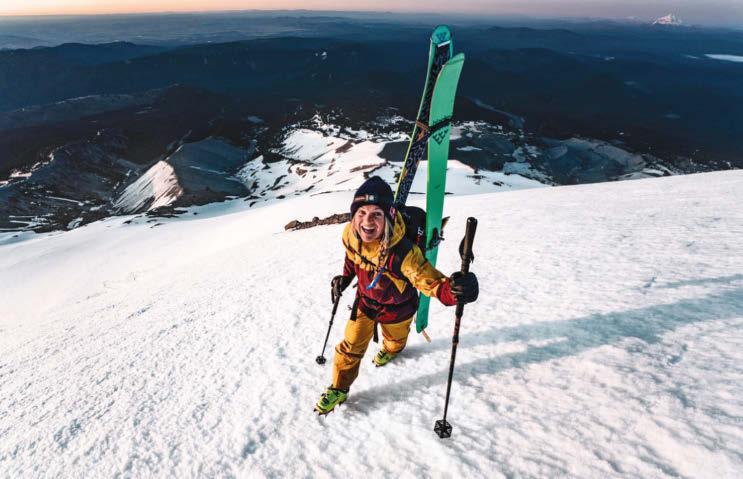
Available now THE MOUNTAIN WHY
Californian pro freeskier Cody Townsend was in the middle of a mission to climb and ski the “Fifty Classic Ski Descents of North America”, as detailed in the 2010 book of the same name, when 2020 ruined his plans. Realizing his three-year timeframe was now unachievable, he decided to continue his quest—accompanied by fellow skiing pro Michelle Parker (pictured)—in a socially distanced and altogether more exerting way. So, the pair bike-packed 1,662km across America with climbing, skiing and camping gear, to tick off three of the classic ski runs in Oregon and Washington State before the last of 2020’s skiable snow ran out. Why? The answer lies at the heart of this film. redbull.com
SPRING INTO ACTION
Whether you’re at home, on the trail or out on the run, here’s the gear you need to hit your fitness goals this year.
Words JOE LINDSEY
PELOTON BIKE+

Peloton’s new spin machine keeps the original’s compact footprint and whisper-quiet flywheel. But the larger, 23.8-inch touchscreen has upgraded speakers and rotates 360 degrees to make it easier to use Peloton’s library of yoga, strength and off-bike cardio classes. The Auto-Follow setting automatically adjusts pedal resistance to follow the class you’re in. Apple GymKit integration pairs seamlessly with an Apple Watch to share workout data. $2,495 plus membership ($39/month); onepeloton.com

BOSE PORTABLE SMART SPEAKER
Earbuds aren’t for everyone. This speaker uses Bose’s legendary wizardry to create immersive 360-degree sound from one lightweight unit— only 8 inches tall, it fits anywhere in a home gym or workout space. It connects seamlessly to any Bluetooth-enabled device to crank the tunes for your workout. Voice activation offers quick, midplaylist switches to fit your mood. And with 12 hours of play time per charge, it’ll outlast any marathon exercise session. $350; bose.com INDO BOARD ORIGINAL TRAINING PACKAGE
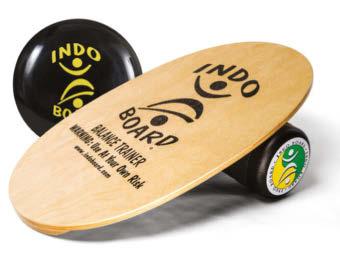
Hunter Joslin designed the original balance board in 1975 to help train surfers, but his ingenious creation will hone balance, strength and proprioception for any sport. This package features a 30x18-inch oval deck made from durable birch plywood. The roller and inflatable cushion offer varying levels of difficulty. Use on its own or to add zip to kettlebell or medicine ball workouts. From $181; indoboard.com TANGRAM SMART ROPE
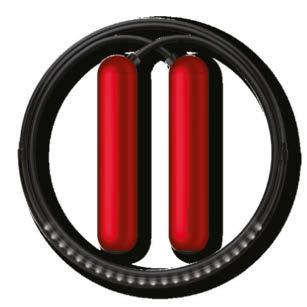
Jumping rope is one of the most powerful cardio workouts you can do. Tangram’s Smart Rope captures metrics that most activity trackers can’t, thanks to sophisticated sensors that capture every jump. LED lights keep track of your workout so you can focus on form and fitness, or competition with friends through the Smart Gym app. The durable rope is tested tougher than conventional versions, and a single charge lasts up to 30 days. $80; tangramfactory.com
NORDICTRACK COMMERCIAL 1750
This update to NordicTrack’s top-selling treadmill is a perfect running partner. With 18 degrees of incline control and speeds up to 12 mph, it’ll dish out interval sufferfests. But with customizable cushioning, it’s great for recovery walks. It’ll instantly adjust to changes in your iFit workout; Google Maps integration lets you hike worldwide. Other iFit classes offer yoga and cardio through the HD touchscreen. $1,799 (includes one year of iFit membership); nordictrack.com ECHELON ROW-S



It’s hard to beat rowing for a full-body, lowimpact workout. The Row S spices it up with live and on-demand classes; a 22-inch touchscreen for vivid virtual environments (it pivots if you switch from rower mode to other Echelon FitPass guided workouts like Core, Boxing or Meditation); and a leaderboard for real-time races. A toggle on the handlebar lets you adjust resistance without stopping midstroke. Starts at $1,640 plus membership ($40/month); echelonfit.com
SENSORIA SMART SOCK V2.0

Raw fitness can take you far as a runner, but bad form limits even great ability. This smart sock has textile sensors that track cadence, foot strike (heel, forefoot, midfoot) and impact score. Sensoria’s app dashboard (iOS only) translates metrics into graphics, with trend analysis to offer insights—like how your form changes with fatigue so you can refine your stride. The odometer function even alerts you when your shoes are shot. $199/pair; sensoriafitness.com

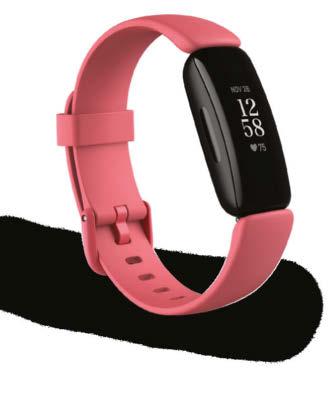
LEOMO TYPE S
This powerful multisport computer might reshape your rides and runs. With two or five (Sensor Kit Pro version) remote sensors you can put anywhere on your body, it records metrics like speed and distance—and tracks proprietary indicators to optimize pedal stroke or running economy. It offers real-time feedback, so you assess changes to shifts in bike fit and stride. The Android OS even handles calls, emails and texts. $449 (two sensor kit); leomo.io FITBIT INSPIRE 2
This compact new fitness tracker features everything you need to stay on top of your health. Think metrics like breath rate, heart-rate variability (a measure of factors like stress) and a workout intensity map that displays which heartrate zones you’re working out in. Sleep metrics help keep tabs on your rest and recovery. It’s waterproof for swim sessions. The streamlined shape and stylish band options make it perfect for all-day use. $80; fitbit.com CORE BODY TEMPERATURE MONITOR
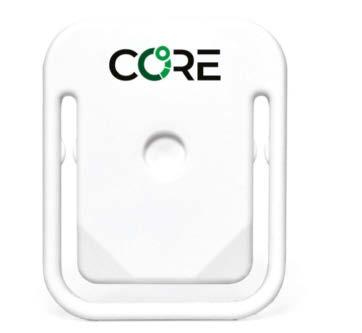
Your body temp shifts during workouts, offering insight into your health, performance and recovery. This noninvasive monitor, tested at the Tour de France, allows smarter heat training and adaptation. Real-time data display (via iOS or Android apps, or Garmin/Wahoo integration) indicates if you’re going too hard for conditions, while long-term tracking helps you acclimatize to hot climates. $280; corebodytemp.com
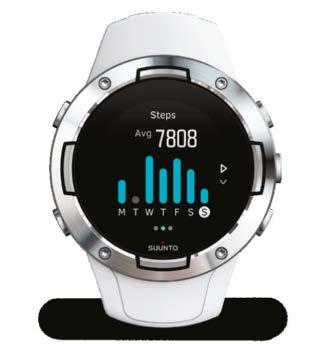
SUUNTO 5
Few sports watches are more versatile than this. With over 80 sport modes (and customizable options), it’s ready for any activity you can dream up. GPS navigation on the watch or paired to a phone offers precise route planning. Adaptive training guidance adjusts intensity based on past activity to help you meet your goals. And 24/7 sleep and stress tracking keep tabs on your recovery and freshness, so you’re at your best for your next adventure. $329; suunto.com
Sensors on the Leomo Type S give you real-time data on your pedal stroke or running economy.
GARMIN VIVOACTIVE 4S
Don’t let this compact sports watch (available with either 40 or 45 mm bezels) fool you; it packs 20 preloaded sports apps into its intuitive navigation for everything from swimming laps to hitting the links. The 4S tracks a massive range of metrics like pulse oxygenation, hydration and sleep. Powerful built-in GPS and capacity for up to 500 songs lets you leave the phone at home. Livetrack incident detection and assistance give you peace of mind when you’re out there solo. $350; garmin.com

Garmin’s Vivoactive 4S is stylish and compact—and extremely capable.



NIKE AIR ZOOM ALPHAFLY NEXT%
Yeah, the name is a mouthful, but if you want a PR in your next long race, the data is clear: This is the shoe to get there. Academic studies show the proprietary ZoomX foam blend and carbonfiber plate helps runners shave several percent off their time on average, and the latest version, which features Zoom Air pucks under the forefoot, may be faster yet. It’s not cheap, but there’s a reason even non-Nike runners are picking them for race days. $275; nike.com
The name is long and the price is steep, but these Nikes are likely to give you a PR.
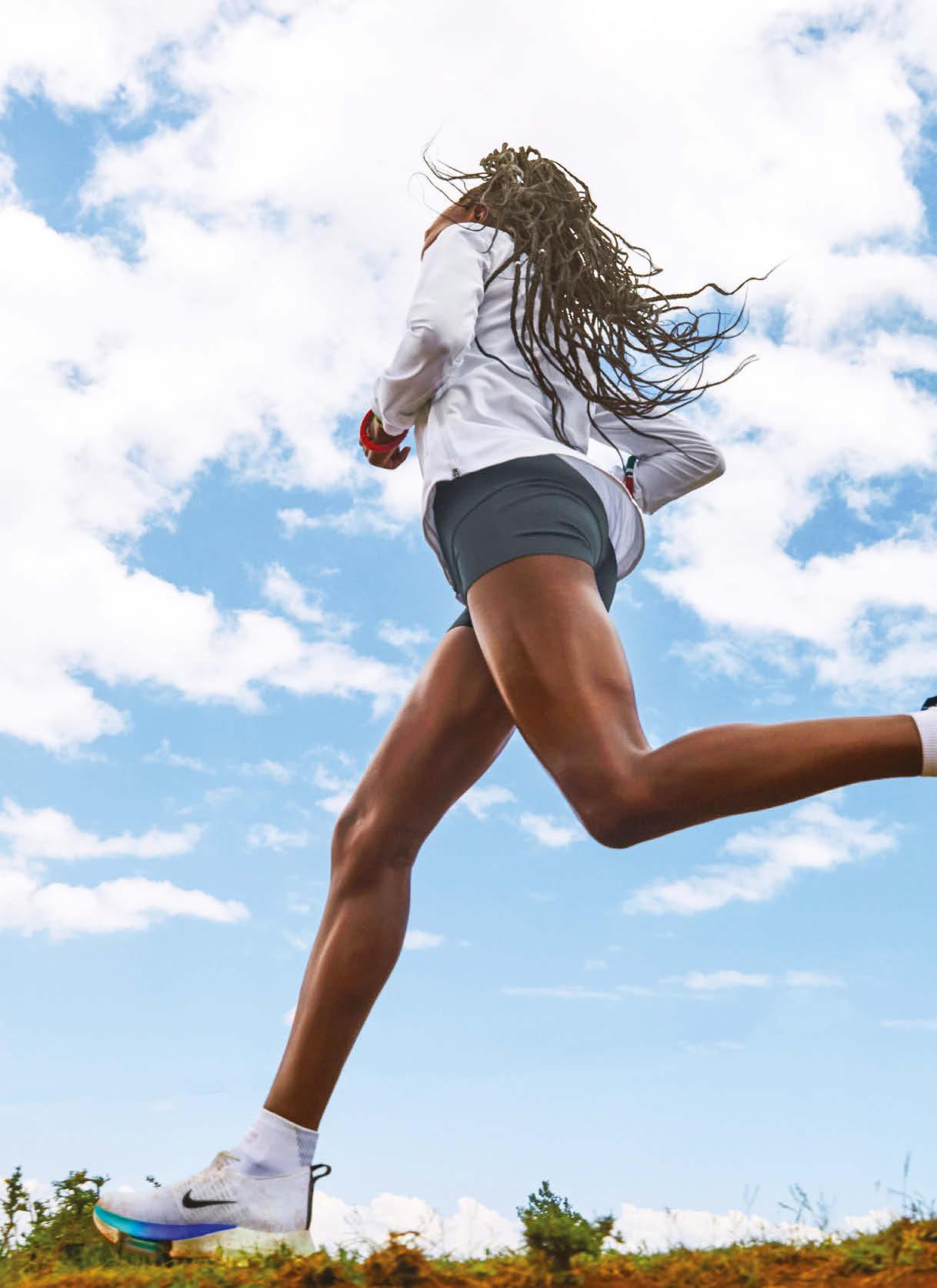
ALTRA OLYMPUS 4
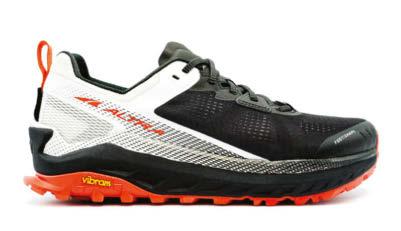
Altra’s founder, Golden Harper, invented Zero Drop with a simple idea: Your feet sit flat, so why do shoes lift your heel? But Zero Drop isn’t just for minimalist-shoe lovers. The Olympus 4 features 33 mm of EVA midsole cushioning for all-day comfort. The Vibram MegaGrip outsole features meaty lugs for sure grip and a wide, extended tail for braking traction on steep stuff. And the mesh upper, cushioned tongue and wide toe box cradle your foot. $170; altrarunning.com BROOKS ADRENALINE GTS 21 SCARPA SPIN ULTRA GTX
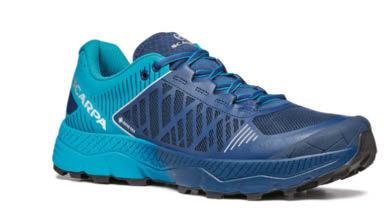

GTS stands for “go-to shoe” and the latest version of the beloved Adrenaline is exactly that: a daily road driver that strikes a balance between support, cushion and durability. DNA Loft foam with a 12 mm heel-toe drop softens even hard heel strikes, while molded guiderail supports channel your power into forward motion. The Air Mesh upper fits perfect from day one and keeps your feet cool even in summer heat. In men’s and women’s versions. $130; brooksrunning.com
The new iteration of Scarpa’s highly regarded Spin line adds a Gore-Tex Invisible Fit waterproof liner that’s bonded to the upper rather than sewn in as a bootie. The result: a lighter, more flexible membrane that preserves the supple, socklike fit of modern knit uppers but still fends off rain and creek crossings. The dual-density midsole and TPU insert offer cushion for hard landings, stability for tricky terrain and protection against rough trails. $169; scarpa.com
UNDER ARMOUR PROJECT ROCK 3
High-intensity gym workouts require a stable foundation. The Project Rock 3 features UA’s Tribase construction and stability chassis, which improves support for explosive moves, whether it’s on the circuit, free weights or CrossFit. The knit, socklike EnergyWeb upper and TPU heel counter hold you locked in and secure for noslip confidence, and the HOVR foam provides exceptional energy return, ideal for HIIT cardio sessions. $140; underarmour.com

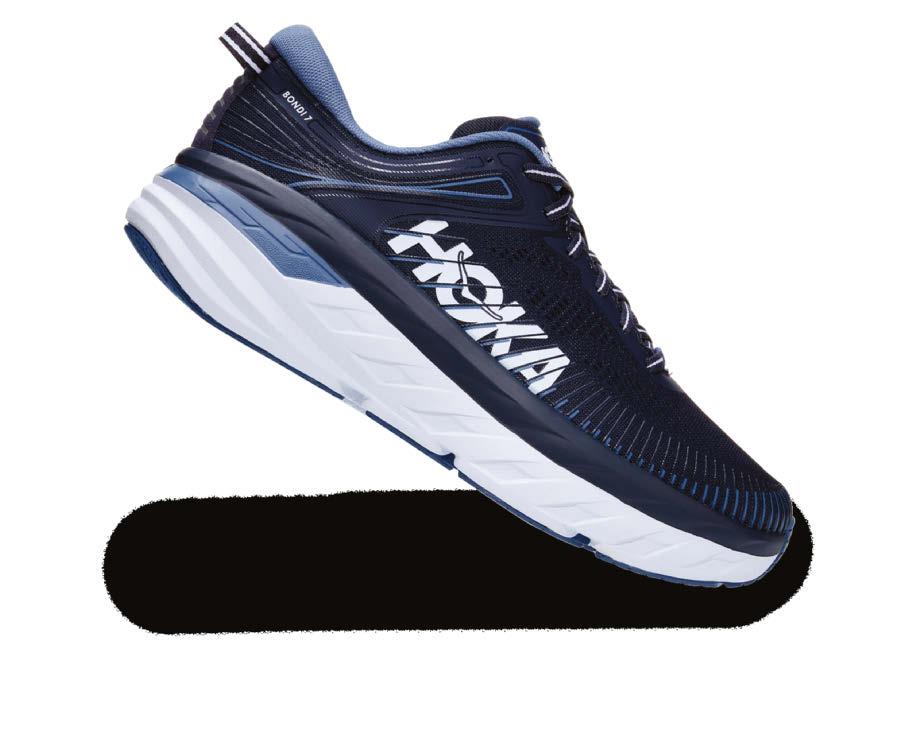
When you want ultimate cushion, look no further than the most- padded shoe from Hoka One One.
HOKA ONE ONE BONDI 7
When you want ultimate cushion, look no further than the most-padded shoe from maximalist evangelists Hoka. With a huge 31 mm of EVA foam in the heel and a modest 4 mm drop to the toe, the Bondi 7 has maximum bounce in a feathery 8.9 oz package. A TPU overlay adds structure to keep your stride mechanics intact, and the beveled heel design offers smooth transitions for rearfoot strikers. For men and women, and in regular and wide lasts. $150; hokaoneone.com
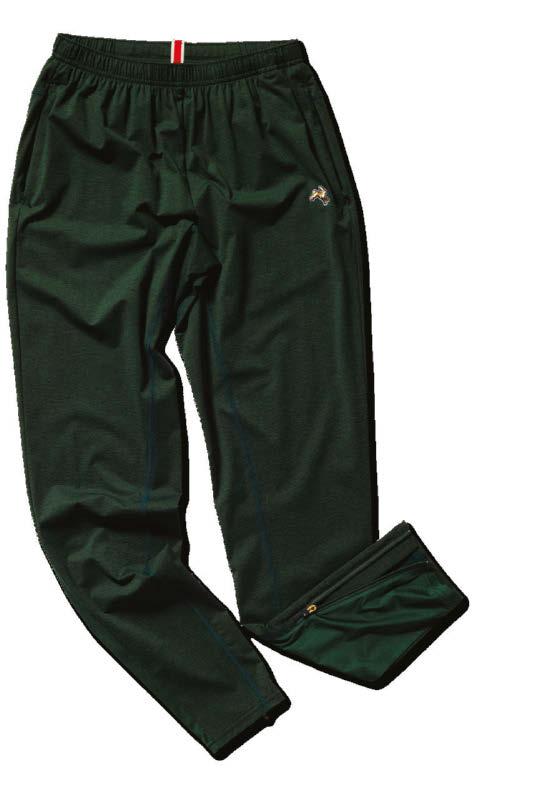
TRACKSMITH SESSION PANTS

Don’t call it a running tight. These pants are cut with a semi-form-fit silhouette that seamlessly goes from a run to lunch with friends to a nap. And the Italian-made Veloce fabric is soft, light and wonderfully stretchy, great for the gym or yoga. Mesh ankles breathe during high-intensity exercise to prevent bothersome cling, while zippered side pockets and a secure rear pocket hold your phone and keys without bouncing. In men’s and women’s styles. $118; tracksmith.com SMARTWOOL MERINO SPORT ULTRA LIGHT HOODIE

Ward off the chill on dawn patrol hikes with this ultralight windshell. The recycled-nylon shell features a snug hood, reflective elements and DWR coating for wind and weather protection, with vented panels on the back and underarms. Zippered waist pockets keep your keys secure, and the 5.2 oz hoodie packs into one for easy storage when it warms up. Available in men’s and women’s styles. $130; smartwool.com
PRANA BECKSA 7/8 LEGGINGS
You may need two pairs of these versatile favorites from Prana because you’re going to live in them. The environmentally friendly bluesigncertified Becksa fabric features a soft, ribbed texture and flatlock seams for comfort. The 1x1 compression ratio offers perfect fit and support. The high-rise cut flatters all body types, and two side pockets and a hidden key pocket in the waistband keep valuables secure. Available in standard and plus-size ranges. $89; prana.com LIFEPROOF LIFEACTIV ARMBAND
Keep your phone—your workout playlist, your GPS run route, your whole digital life—in easy reach with this comfortable, secure armband. Ditch clunky plastic sleeves that mess with touchscreens; the QuickMount system lets you securely fasten the phone with one quick click, and remove with a twist. The system sits flush to your arm to limit bothersome bouncing, and the universal sizing fits biceps up to bodybuilder size. $50; lifeproof.com

OUTDOOR VOICES POWERHOUSE BRA
When you’re really moving, you need ultimate support. This sports bra features molded cups and honeycomb mesh fabric for the perfect amount of compression and structure for highmotion activities like running, CrossFit and dance. Adjustable straps, five band sizes and three cup sizes ensure a proper fit for all body shapes and sizes. The front zipper means no more fighting to get into the bra, and the inside clasp keeps you securely zipped. $24; outdoorvoices.com
These Tracksmith pants are great for running, yoga, the gym, lunch with friends or even a nap.
Pearl Izumi’s Rove shorts are ideal for a ride—and a bunch of other uses.
PEARL IZUMI ROVE SHORT
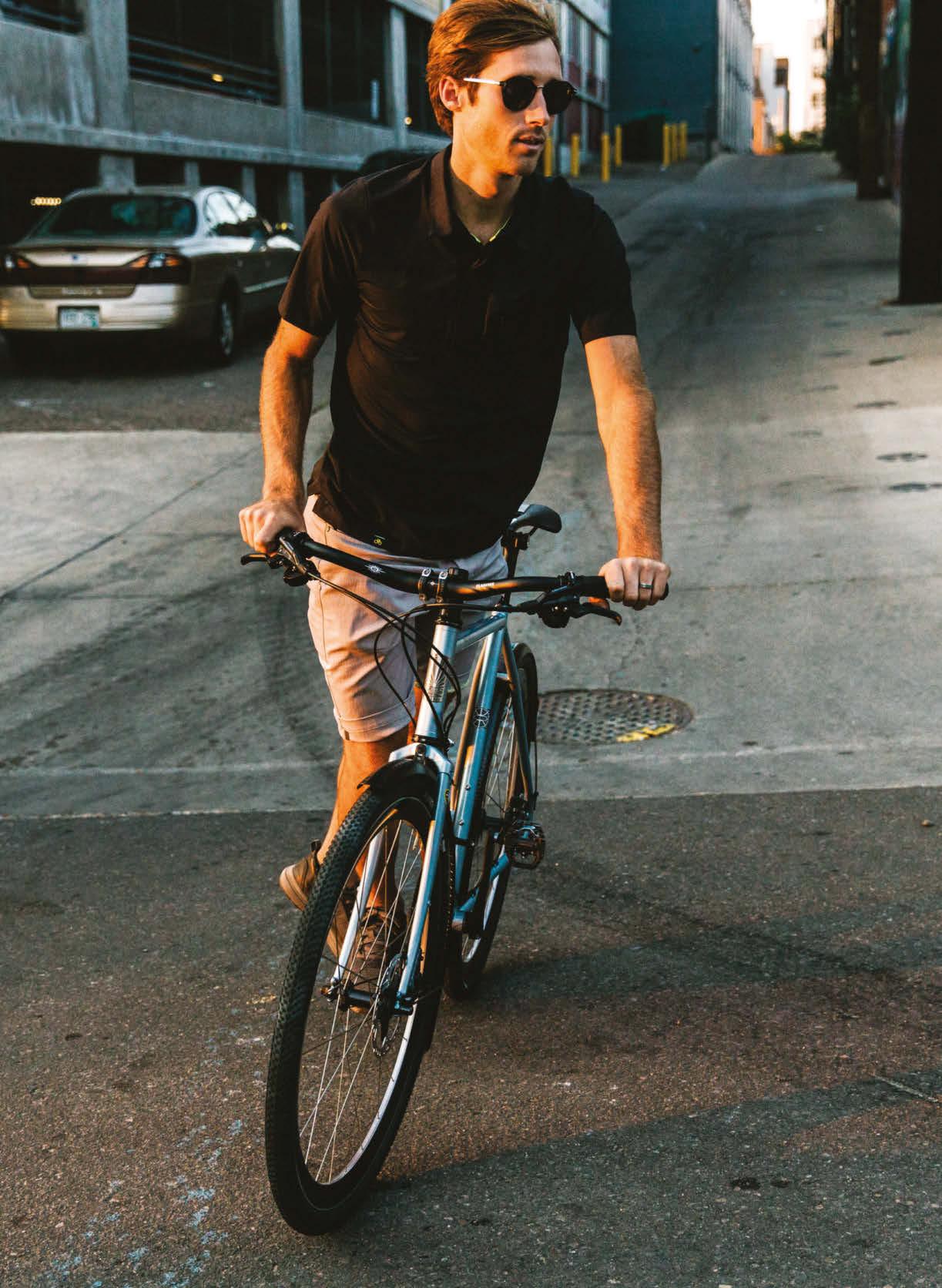
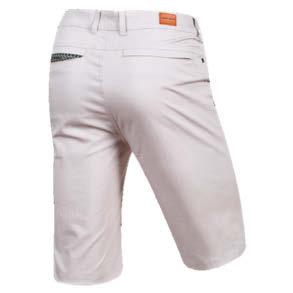
This riding short is for more than just bike trips. A gusseted crotch keeps seams out of the way for riding, but the cotton-nylon Oxford fabric features an ideal amount of four-way stretch for fitness classes. The waistband sits higher in the back for full coverage on the bike or in downward dog. With a straight, fitted cut and 12.5-inch inseam that sits just above the knee, this fashionable short looks equally at home working out or around town. $90; pearlizumi.com
GLOBAL TEAM
Head of The Red Bulletin Alexander Müller-Macheck, Sara Car-Varming (deputy) Editors-in-Chief Andreas Rottenschlager, Andreas Wollinger (deputy) Creative Directors Erik Turek, Kasimir Reimann (deputy) Art Directors Marion Bernert-Thomann, Miles English, Tara Thompson Designers Martina de Carvalho-Hutter, Kevin Goll, Carita Najewitz Photo Editors Eva Kerschbaum (manager), Marion Batty (deputy), Susie Forman, Tahira Mirza, Rudi Übelhör Digital Editors Christian Eberle-Abasolo (manager), Elena Rodriguez Angelina, Benjamin Sullivan Special Projects Florian Obkircher, Arkadiusz Piatek Managing Editors Ulrich Corazza, Marion Lukas-Wildmann Publishing Management Ivona Glibusic, Bernhard Schmied, Anna Wilczek Managing Director Stefan Ebner Head of Media Sales & Partnerships Lukas Scharmbacher Head of Co-Publishing Susanne Degn-Pfleger Project Management Co-Publishing, B2B Marketing & Communication Katrin Sigl (manager), Mathias Blaha, Katrin Dollenz, Thomas Hammerschmied, Teresa Kronreif (B2B), Eva Pech, Valentina Pierer, Stefan Portenkirchner (communication) Creative Services Verena Schörkhuber-Zöhrer (manager), Sara Wonka, Julia Bianca Zmek, Edith Zöchling-Marchart Commercial Management Co-Publishing Alexandra Ita Editorial Co-Publishing Raffael Fritz (manager), Gundi Bittermann, Mariella Reithoffer, Wolfgang Wieser Executive Creative Director Markus Kietreiber Project Management Creative Elisabeth Kopanz Art Direction Co-Publishing Dominik Uhl (manager), Stefanie Werth, Andreea Parvu Commercial Design Peter Knehtl (manager), Simone Fischer, Martina Maier, Alexandra Schendl, Julia Schinzel, Florian Solly, Stephan Zenz Subscriptions and Distribution Peter Schiffer (manager), Marija Althajm, Nicole Glaser, Victoria Schwärzler, Yoldaş Yarar Advertising Manuela Brandstätter, Monika Spitaler Production Veronika Felder (manager), Friedrich Indich, Walter O. Sádaba, Sabine Wessig Repro Clemens Ragotzky (manager), Claudia Heis, Nenad Isailović, Sandra Maiko Krutz, Josef Mühlbacher Finance Mariia Gerutska (manager), Klaus Pleninger MIT Christoph Kocsisek, Michael Thaler Operations Melanie Grasserbauer, Alexander Peham, Yvonne Tremmel Project Management Gabriela-Teresa Humer Editor and CEO Andreas Kornhofer Editorial office Heinrich-Collin-Straße 1, A-1140 Vienna Phone +43 1 90221-0 Web redbulletin.com Published by Red Bull Media House GmbH, Oberst-Lepperdinger-Straße 11–15, A-5071 Wals bei Salzburg, FN 297115i, Landesgericht Salzburg, ATU63611700 Executive Directors Dkfm. Dietrich Mateschitz, Dietmar Otti, Christopher Reindl, Marcus Weber THE RED BULLETIN USA, Vol 10 Issue 5, ISSN 2308-586X is published monthly except combined January/February and July/August issues by Red Bull Media House, North America, 1740 Stewart St., Santa Monica, CA 90404. Periodicals postage paid at Santa Monica, CA, and additional mailing offices. ATTENTION POSTMASTER: Send address changes to THE RED BULLETIN, PO Box 469002, Escondido, CA 92046. Editor-in-Chief Peter Flax Deputy Editor Nora O’Donnell Art Director Tara Thompson Copy Chief David Caplan Publishing Management Branden Peters Media Network Communications & Marketing Manager Brandon Peters Advertising Sales Todd Peters, todd.peters@redbull.com Dave Szych, dave.szych@redbull.com Tanya Foster, tanya.foster@redbull.com Printed by Quad/Graphics, Inc., 668 Gravel Pike, East Greenville, PA 18041, qg.com Mailing Address PO Box 469002 Escondido, CA 92046 US Office 2700 Pennsylvania Ave. Santa Monica, CA 90404 Subscribe getredbulletin.com, subscription@us.redbulletin.com. Basic subscription rate is $29.95 per year. Offer available in the US and US possessions only. The Red Bulletin is published 10 times a year. Please allow four to six weeks for delivery of the first issue. Customer Service 855-492-1650; subscription@us.redbulletin.com
THE RED BULLETIN Austria, ISSN 1995-8838 Editor Wolfgang Wieser Proofreaders Hans Fleißner (manager), Petra Hannert, Monika Hasleder, Billy Kirnbauer-Walek Publishing Management Bernhard Schmied Media Sales & Partnerships Thomas Hutterer (manager), Alfred Vrej Minassian, Franz Fellner, Daniela Güpner, Gabriele MatijevicBeisteiner, Wolfgang Kröll, Nicole Okasek-Lang, Britta Pucher, Jennifer Sabejew, Thomas Gubier, Johannes Wahrmann-Schär, Ellen Wittmann-Sochor, Ute Wolker, Christian Wörndle, Sabine Zölß; Kristina Krizmanic (Team Assistant) THE RED BULLETIN France, ISSN 2225-4722 Editor Pierre-Henri Camy Country Coordinator Christine Vitel Country Project Management Youri Cviklinski
THE RED BULLETIN Germany, ISSN 2079-4258 Editor David Mayer Proofreaders Hans Fleißner (manager), Petra Hannert, Monika Hasleder, Billy Kirnbauer-Walek Country Project Management Natascha Djodat Media Sales & Partnerships Thomas Hutterer (manager), Alfred Vrej Minassian, Franz Fellner, Gabriele Matijevic-Beisteiner, Nicole Okasek-Lang, Britta Pucher, Jennifer Sabejew, Thomas Gubier, Johannes Wahrmann-Schär, Ellen Wittmann-Sochor, Sabine Zölß
THE RED BULLETIN Switzerland, ISSN 2308-5886 Editor Wolfgang Wieser Country Project Management Meike Koch Commercial & Brand Partnerships Manager Stefan Bruetsch Advertising Sales Marcel Bannwart (D-CH), marcel.bannwart@redbull.com Christian Bürgi (W-CH), christian.buergi@redbull.com
THE RED BULLETIN United Kingdom, ISSN 2308-5894 Editor Ruth McLeod Associate Editor Tom Guise Culture Editor Florian Obkircher Chief Sub-Editor Davydd Chong Publishing Management Ollie Stretton Advertising Sales Mark Bishop, mark.bishop@redbull.com Fabienne Peters, fabienne.peters@redbull.com USPS STATEMENT OF OWNERSHIP, MANAGEMENT, AND CIRCULATION (required by 30 UCS 3685) Publication title: The Red Bulletin Publication #: Volume 10 Issue 5, ISSN 2 308-586X Filing Date: 10/1/2020 Issue Frequency: Monthly except for 2 issues, Jan/Feb and July/Aug Number of Issues Published Annually: 10 Annual Subscription Price: $29.95 Complete Mailing Address of Known Office of Publication: 1740 Stewart St., Santa Monica, CA 90404-4022 Contact Person: Laurie Levasseur Publishing Mangement: Branden Peters Editor-in-Chief: Peter Flax Owner: Red Bull Media House GmbH at Oberst-Lepperdinger-StraBe 11-15, A-5071 Wals bei Salzburg, FN 297115i, Landesgericht Salzburg, ATU63611700 Known Bondholders. Mortgagees and Other Security Holders Owning or Holding 1% or more of Total Amount of Bonds, Mortgages or Other Securities: None Tax status: Has not changed AVERAGE NUMBER OF COPIES EACH ISSUE DURING PRECEDING 12 MONTHS a. Total Number of Copies (net press run): 395,015 b. Paid and/or Requested Circulation: 340,127 / Newsstand Sell-thru: 491 c. Total Paid and/or Requested Distribution: 340,618 d. Non-Requested Distribution: 25,118 / Sampling: 19,951 e. Total Free Distribution: 45,069 f. Total Distribution: 385,686 g. Copies Not Distributed: 9,329 h. Total: 395,015 i. Percent Paid or Requested: 88.3% Issue Date for Circulation Data Below: August/September 2020 a. Total Number of Copies (net press run): 321,052 b. Paid and/or Requested Circulation: 315,252 / Newsstand Sell-thru: 250 c. Total Paid and/or Requested Distribution: 315,502 d. Non-Requested Distribution: 520 / Sampling: 280 e. Total Free Distribution: 800 f. Total Distribution: 316,302 g. Copies Not Distributed: 4,750 h. Total: 321,052 i. Percent Paid or Requested: 99.7%
I certify that the above statements are correct and complete. Peter Flax (US Editor-in-Chief)
Disclaimer If you subscribed to The Red Bulletin magazine in the USA either by mail, online or other method, we may send you offers through direct mail that we feel might be of interest to you and/or share your name and mailing address and certain other information, such as when you first subscribed, with reputable companies that provide marketing offers through direct mail. If you do not want us to send you any offers from third parties through direct mail or share your personal Information with other companies so that they can send you direct mail offers about their products and services, please write to us at the street address or subscription email address above. Please note that even if you opt out of receiving promotional direct mail offers, we may continue to send you service notifications by direct mail that are related to your The Red Bulletin account(s).

Wingin’ it
The county of Møre og Romsdal in Western Norway is home to Mardelsfossen, one of Europe’s tallest waterfalls. The merest mention of the word “fall” last August was enough to get Marco Waltenspiel, Marco Fürst and Max Manow of the Red Bull
Skydive Team pulling on their wingsuits and flinging themselves into the void. To see these super fly guys in action, drop into redbull.com. The next issue of THE RED BULLETIN is out on March 16.
